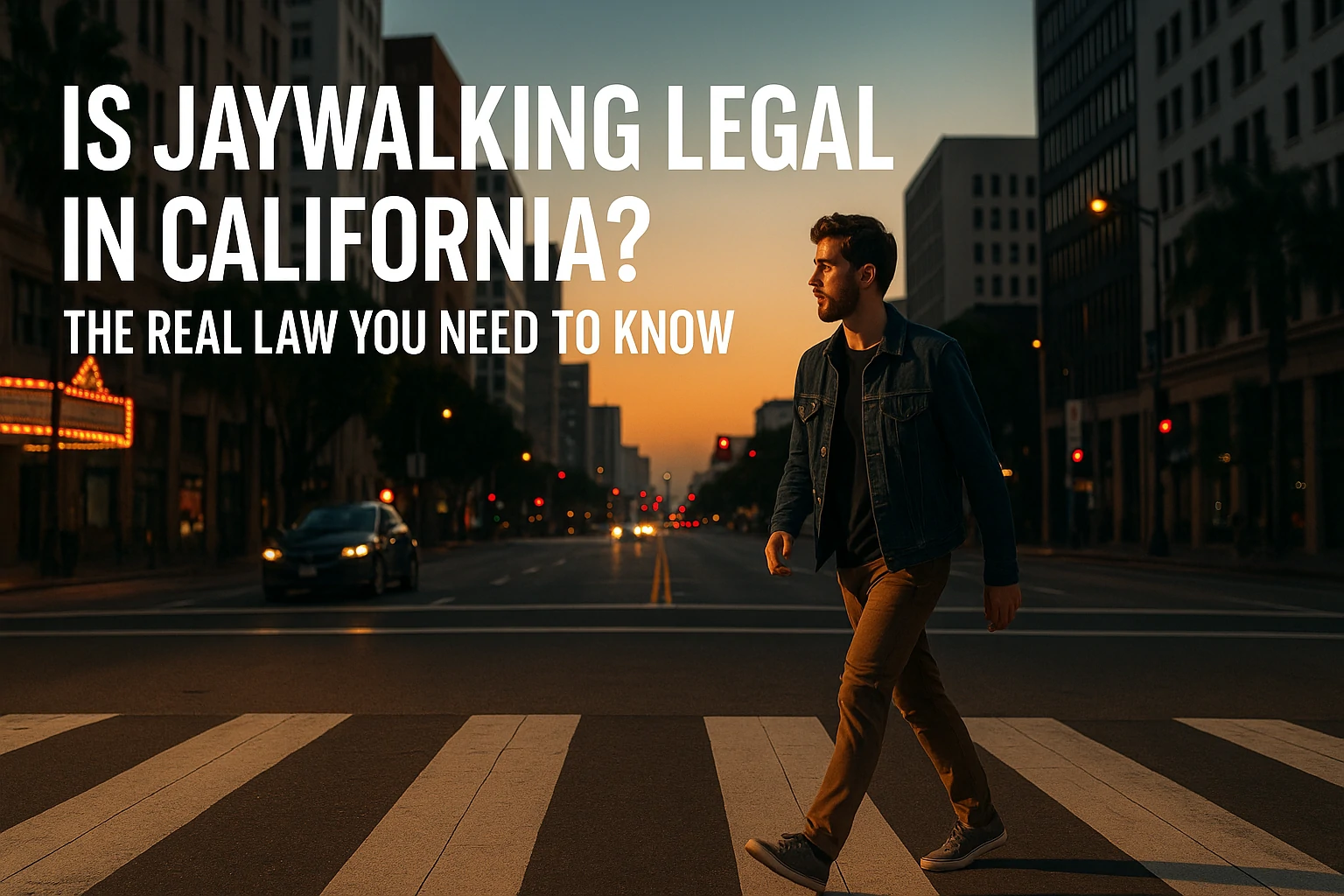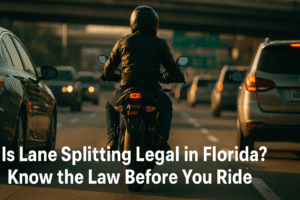People often cross the street without using a crosswalk. Some do it to save time. Others do it out of habit. This is called jaywalking. It may not look serious, but in some states, it can bring a fine.
California used to have strict rules about this. In many places, crossing outside a marked path could lead to a ticket. Even when no cars were around, police could still stop you. Many said the law was unfair. They said it hurt poor and minority communities the most.
That led to change. In 2023, California passed a new rule. It gives people more freedom to cross the street. Still, it only applies when there is no danger. If traffic is close or drivers must stop, you can still face legal trouble.
This guide explains the new law. You will learn what is now allowed, what is still illegal, and how to stay safe. If you live in California or plan to visit, this knowledge can help you walk with confidence and avoid problems.
What Is Jaywalking?
Jaywalking means crossing the street where the law does not allow it. This can happen between intersections or outside a marked crosswalk. Some also use the word when a person steps into traffic during a red light or before the walk signal appears.
Is It a Crime?
Jaywalking is not treated like theft or assault. It does not lead to jail. But it can still bring a fine. In some areas, police may stop or hold someone if they think that person creates a danger.
Why Cities Have Crossing Rules
Most cities in the U.S. have clear rules about where and when people can cross. These rules aim to prevent crashes and keep traffic safe. Still, many people believe the old jaywalking laws were unfair. Some say they caused more harm than they prevented.
Why Did California Change the Law?
In recent years, lawmakers saw problems with strict jaywalking rules. Many people spoke out about safety, fairness, and police abuse. In cities like Los Angeles and Oakland, some said the law was used more against people of color.
The old rules gave police too much power. Even if someone crossed safely, they could still get a ticket. News stories and videos showed stops that turned into arrests or worse.
Money also became a concern. Tickets cost a lot. Some people could not pay. They ended up with late fees or court trouble. Lawmakers asked a simple question. Should someone face legal problems just for crossing the street without causing harm?
This led to Assembly Bill 2147. It became known as the “Freedom to Walk Act.” Lawmakers passed it in 2022. It took effect in January 2023. The law now allows safe street crossing, even outside of marked crosswalks. It aims to stop unfair stops and lower police tension.
History of Jaywalking Laws in the U.S.

Jaywalking was not always against the law. In the early 1900s, streets were shared by everyone. People walked freely. Carts, bikes, and even animals used the same roads. There were no clear rules, and most people crossed where they wanted.
Then, cars took over. Speeds rose. Crashes became common. At first, the public blamed drivers. But car makers and city leaders wanted to protect the growing auto industry. They pushed a new idea. They called careless walkers “jaywalkers.” The word made people sound foolish, like they did not belong in the street.
By the 1920s and 1930s, cities passed laws to stop mid-block crossing. These new rules helped drivers and gave order to traffic. Police began to enforce them. Jaywalking slowly turned from a safety issue into a crime.
California joined this trend. Local leaders passed tough rules. Some cities banned all crossing unless it was at a light or a marked spot. The goal was safety. But the rules often hurt low-income and minority groups. Many people still had to walk, but the law worked against them.
The rules stayed in place for decades. Now, things are changing. California has started to shift back. The focus is moving toward safety and fairness, not punishment.
What the New Jaywalking Law Says
The Freedom to Walk Act does not make jaywalking legal in every case. It removes fines only when the person crosses in a safe way. If no cars are close enough to cause danger, police cannot stop or ticket you.
The law still allows tickets in risky situations. If you dart into traffic, ignore signals, or cross in a way that could cause harm, police can still take action. The rule protects smart choices, not reckless ones.
The bill changed parts of the California Vehicle Code. Now, officers must decide if the person crossed in a truly dangerous way before they act. This change gives people more freedom, but it still puts safety first.
Jaywalking Laws in Other States
California is not the only state that faces debate over jaywalking laws. Each state sets its own rules. Some are strict. Others offer more freedom to pedestrians.
In New York, jaywalking is illegal. You can get a ticket for crossing against a signal or outside a crosswalk. Still, police often ignore it unless someone causes danger.
Texas also bans jaywalking in most cities. Crossing mid-block or ignoring signs can bring a fine. In Austin, some groups have pushed to reduce strict enforcement.
Oregon treats jaywalking as a traffic offense. Police can give tickets, and fines may be high. Portland has discussed change, but the rules remain tough.
Nevada takes a strong approach. In Las Vegas, police watch for unsafe crossings, especially on the Strip. Tourists often get cited for jaywalking.
Some states, like Colorado and Washington, use a softer approach. They still have rules, but police often give warnings instead of tickets.
Compared to these states, California now stands out. Its new law gives more power to people on foot. It puts focus on safety, not just where someone crosses.
Why Jaywalking Was Criminalized in the First Place
Jaywalking laws began with the rise of cars. In the early 1900s, streets were shared by all. People walked freely. Children played in the roads. Horse carts moved slowly, so crashes were rare.
Then cars took over. Speeds rose. Accidents increased. Many walkers were hurt or killed. At first, the blame went to drivers. Courts often sided with pedestrians.
The car industry pushed back. Makers and auto clubs feared lawsuits and strict rules. They worked to change public views. They wanted roads to belong to cars, not people.
They ran media ads and school talks to spread the idea of jaywalking. The word “jay” meant someone foolish. It made walkers seem careless. Their plan worked. Cities passed laws that limited where people could cross.
These laws were not only about safety. They aimed to keep roads clear for fast traffic. Cars gained the right of way. Pedestrians lost space.
Over time, the public accepted this shift. But critics say it punished walkers, mainly in busy or poor areas. A simple street crossing became a legal risk.
Public Opinion on Jaywalking in California
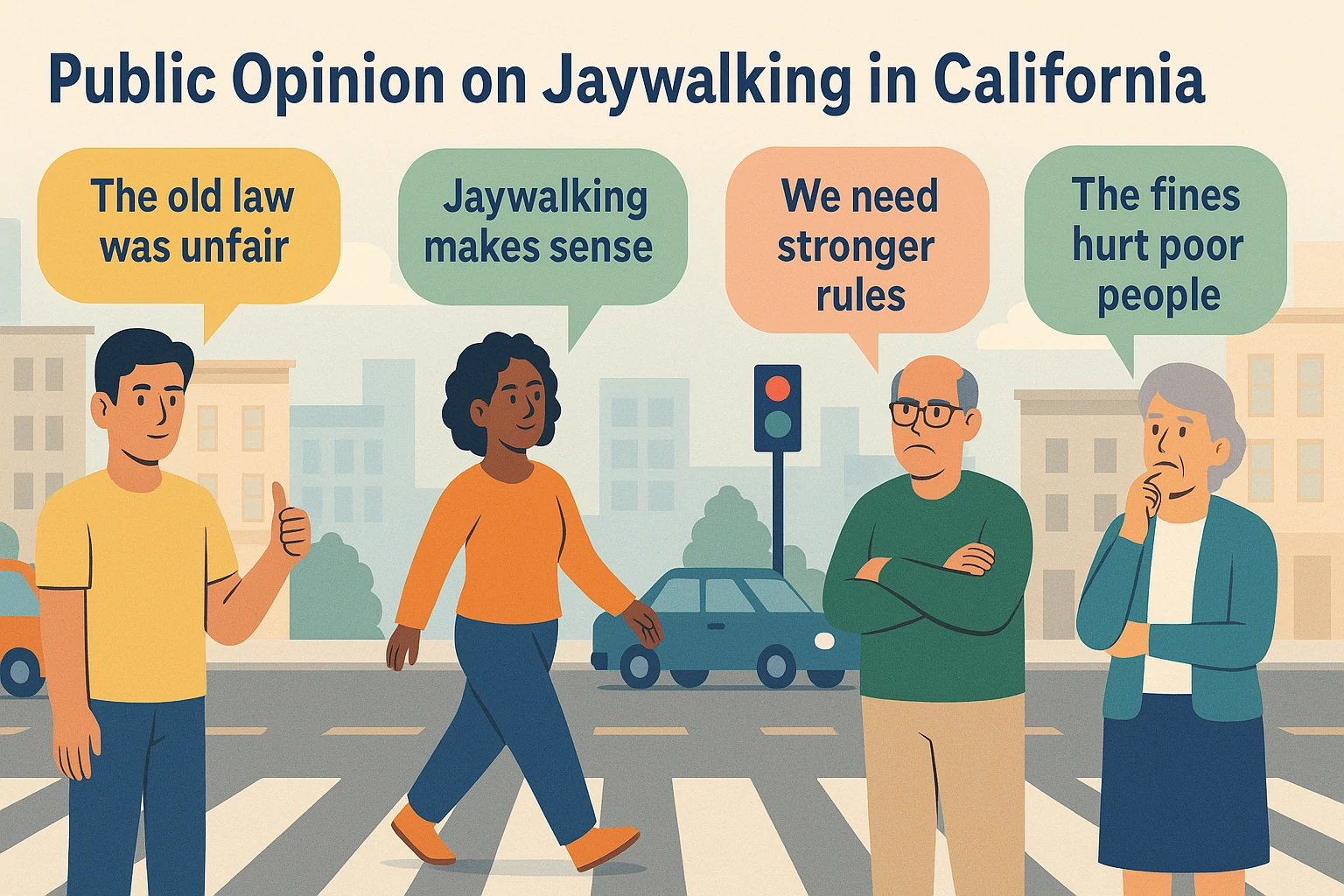
Many Californians feel the old jaywalking laws were unfair. They say it made no sense to get a ticket for crossing an empty street. The rules seemed harsh and out of touch with real life.
In cities like Los Angeles and San Francisco, jaywalking is common. People walk long blocks, and crosswalks are often far apart. When the street is clear, they cross mid-block. They see it as smart, not dangerous.
Some believe the old law gave police too much power. News clips and reports showed people stopped even when they caused no harm. This raised concerns about racial bias and unfair targeting.
Others say the law punished poor people. Some avoided walking. Others paid high fines they could not afford. The rule hurt more than it helped. It scared people instead of keeping them safe.
Still, not everyone agrees. A few support strict rules. They say laws bring order. They believe clear rules help prevent accidents. They fear the new law may lead to careless street crossing.
But public feedback tells a different story. Surveys and hearings show most people want safe freedom. They want the law to focus on risk, not just location. The new rule reflects this shift. It proves that laws can change when the public speaks.
Jaywalking and Racial Justice: A Deeper Look
The debate over jaywalking in California runs deeper than traffic rules. Civil rights groups raised concerns for years. Data showed that Black and Latino people were stopped more often than others. Many of these stops did not improve safety. They added tension between police and the public.
In cities like Oakland and Los Angeles, people shared real stories. Some were stopped for crossing empty streets. Others were searched, fined, or even arrested. These events created fear and broke trust in law enforcement.
Reports showed that most stops happened in low-income areas. In many cases, police used jaywalking laws to stop people without clear cause. Critics said looks, not actions, led to these stops. That made the law feel unfair and dangerous.
The cost of tickets made things worse. Many people could not pay. A small fine grew into court dates, extra fees, or warrants. What began as a simple ticket became a legal trap.
Supporters of change spoke out. They said the law hurt the people it claimed to protect. They argued that no one should face legal trouble for crossing the street safely. Lawmakers agreed and passed a new rule. This was not just about walking. It was about fairness, respect, and trust.
The new law is part of a larger push to rethink small violations. It aims to protect safety without unfair policing. It gives people more freedom and limits abuse of power.
What Pedestrians Should Still Avoid
The new law gives people more freedom to cross the street. But it does not remove all rules. Pedestrians still need to follow basic safety steps to avoid danger and fines.
Do not trust that a street is clear just because it looks empty. Always check both sides. Cars may appear quickly, especially on wide streets or near hills. Never guess. Be sure.
Do not cross if drivers must brake or turn to avoid you. If your move causes a car to slow down fast or swerve, police can still give you a ticket. The law sees that as unsafe.
Stay away from areas with low visibility. This includes dark roads, sharp bends, or spots blocked by parked cars. Even if signs don’t ban it, crossing in those places can be deadly.
Avoid distractions. Many people walk with eyes on their phones or wear headphones. They miss sounds or movement. This can lead to poor timing and real danger. Keep your focus on the street.
Do not step between stopped cars in traffic. Other drivers may not see you. You could get hit. Wait for traffic to clear or find a safer place to cross.
In short, the law gives you more freedom, but you must use it wisely. Think before stepping into the road. Stay alert. Your safety still depends on smart choices.
Are Jaywalking Tickets Still Enforced in California?
Many people think jaywalking is now fully legal in California. That is not true. The new law removed tickets only in safe cases. If you cross without risk to yourself or others, you should not get a fine. But if your move creates danger, police can still take action.
Officers still have the power to stop and cite people. If someone walks into fast traffic, skips signals, or causes a driver to brake or swerve, they may face a fine. The law cares about danger, not the place where you cross.
Since 2023, most cities have cut back on jaywalking stops. Officers now focus on clear safety risks. Minor street crossings rarely get attention. Some police groups say this change helps them use time and staff more wisely.
Still, some tickets have been issued. Most came from clear violations, like people running red lights or stepping into traffic that was already moving.
If you believe your ticket was unfair, you have options. You can fight it in court. Write down the time, place, and traffic details. Take photos or video if you can. Some legal aid groups help low-income residents with these cases.
So yes, tickets still happen. But the goal has changed. The law now aims to stop harm, not punish safe steps across an empty street.
How Cities Are Adapting to the New Law
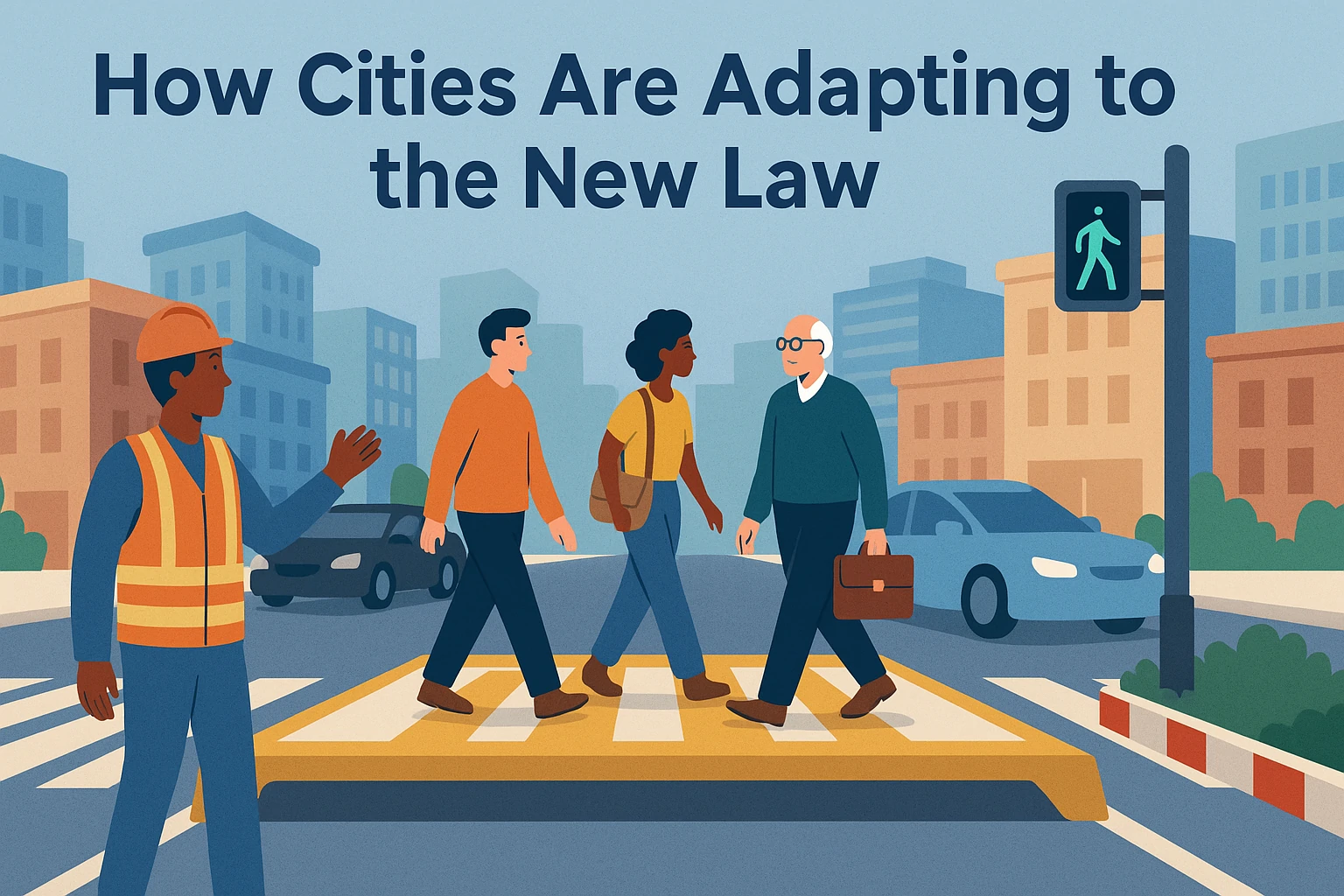
Cities across California are adjusting to the new jaywalking rules. Some are training police in new ways. Others are redesigning streets to improve safety without giving out more tickets.
In San Francisco, leaders now focus on better street design. They want to protect both walkers and drivers. The city is adding raised crosswalks, stronger lighting, and islands in wide streets to help people cross safely.
Los Angeles is also making changes. In busy neighborhoods, the city has added more signals. Flashing lights and beacons now warn drivers when someone is crossing.
Police departments across the state are updating their policies. Many now tell officers to give jaywalking tickets only in rare, risky cases. This helps cut down conflict and allows officers to focus on bigger issues.
City councils are working with health and safety groups. They help people learn the new rules. Flyers, social media posts, and events teach what is safe, what is not, and how to cross without risk.
This new approach also lowers tension between officers and the public. The focus has moved from punishment to prevention. It helps rebuild trust and makes streets safer for everyone.
Each city uses its own plan. But the trend is clear. Local leaders now push for safer design, not strict enforcement.
What to Do If You Witness Unsafe Jaywalking
Seeing someone cross the street in a risky way can cause concern. You may fear for their safety or the safety of others nearby. The new law allows safe street crossing outside crosswalks. But dangerous actions are still a problem.
If you see someone run into traffic, ignore signals, or cause a near crash, stay calm. Do not try to block or stop them. That can make things worse. Instead, take note of what you saw. If the risk is real, report it to local officials. Some cities offer non-emergency phone numbers or apps for this purpose.
You can also help through education. Many people still do not understand what the new law says. If you know the rules, share them with friends or neighbors. Spread the message with care. Avoid blame.
In your area, look for local safety groups. Near schools or parks, many neighborhoods hold safety walks or audits. These events point out danger spots and help push for safer roads.
If one person keeps crossing in a dangerous way, and it happens near kids or older adults, talk to a local leader. A community officer may offer help or provide flyers to share with others.
Keeping roads safe is not just the job of police or lawmakers. It starts with people who care about their community. A simple warning, shared advice, or a small report can stop an injury. It may even save a life.
Can Children or Teens Jaywalk Under This Law?
The new California jaywalking law applies to everyone, including minors. But children and teens must still follow the same rule, cross only when it’s safe. The law does not give special protection based on age. If a young person crosses the road in a way that creates risk, they may still face a warning or citation.
In practice, police often handle youth violations with care. They may issue a verbal warning or contact a parent instead of giving a fine. Still, schools and parents must teach children the limits of the new law. Kids may think they can cross anywhere, anytime. That’s not true.
Teens may take more chances. They often use phones, listen to music, or rush across streets without looking. These habits increase danger. The law gives more freedom, but that freedom requires maturity and awareness, qualities that younger people are still learning.
School zones remain strict. Crossing guards, signs, and signals help manage foot traffic. Students should always follow posted rules around school grounds. Crossing in safe spots helps prevent accidents and sets a good example for others.
Parents can help by walking with children and explaining road safety. Talk about how to judge traffic, check both ways, and avoid distractions. Make sure kids understand that the law does not protect them if they make risky choices.
In short, yes, children and teens can benefit from the new rule. But they must use it with caution. Adults should guide them until they fully understand how to cross safely on their own.
How the New Jaywalking Law Works

- Jaywalking is no longer a ticketable offense if done safely.
- Police cannot stop you just for crossing outside a crosswalk.
- If your crossing poses a risk, you can still be cited.
- The law took effect on January 1, 2023.
This new rule gives more freedom but also puts more responsibility on pedestrians. You must still use good judgment when crossing the road.
What Does Safe Conditions Mean?
The phrase “safe conditions” is key to the new law. But what does it really mean?
In simple terms, you should only cross when there are no cars nearby that could hit you. This could mean checking both sides of the road and waiting until traffic is clear.
“Safe” also depends on the location. In a quiet neighborhood, a safe crossing might be easier than on a busy city street. Visibility also matters. If it’s dark, rainy, or foggy, your view and driver response time change. In those cases, the same action might not be safe.
If a driver must slow down, swerve, or stop suddenly, then your crossing might not count as safe. That can lead to a ticket. Police still have the right to issue a citation if they see clear danger.
In short, use your eyes, ears, and common sense. The law gives you more freedom, but you must use it wisely.
The Role of Police Under the New Law
Under the old rules, police could stop anyone who crossed outside of legal walkways. This gave them wide control. Critics said this led to abuse and unnecessary force.
Now, officers must follow a different rule. They can only intervene if a person clearly causes or risks harm. This puts a check on police power and reduces the chance of unfair stops.
Police can still stop someone if the crossing leads to danger. For example, if a person runs into traffic, ignores signals, or walks while distracted, the officer can take action.
This change aims to build trust and fairness. It also helps reduce the use of force in minor cases. Lawmakers hope it leads to safer communities.
Who Benefits from the Change?
Many groups gain from this update. Urban residents often cross streets mid-block, especially in dense cities with long distances between crosswalks. Under the old law, they faced high fines and risk of confrontation.
Low-income communities also benefit. In the past, people who could not pay tickets ended up with bigger legal trouble. A simple street crossing could turn into court visits, unpaid debt, or even warrants.
Racial justice groups supported the bill, citing data that showed Black and Latino pedestrians were more likely to be stopped for jaywalking. The new law helps reduce these gaps in enforcement.
Tourists and visitors may also feel safer. Many come from places where crossing the street is more relaxed. The update reduces the shock of facing legal action for walking across a quiet road.
Real-Life Examples: What’s Allowed Now?
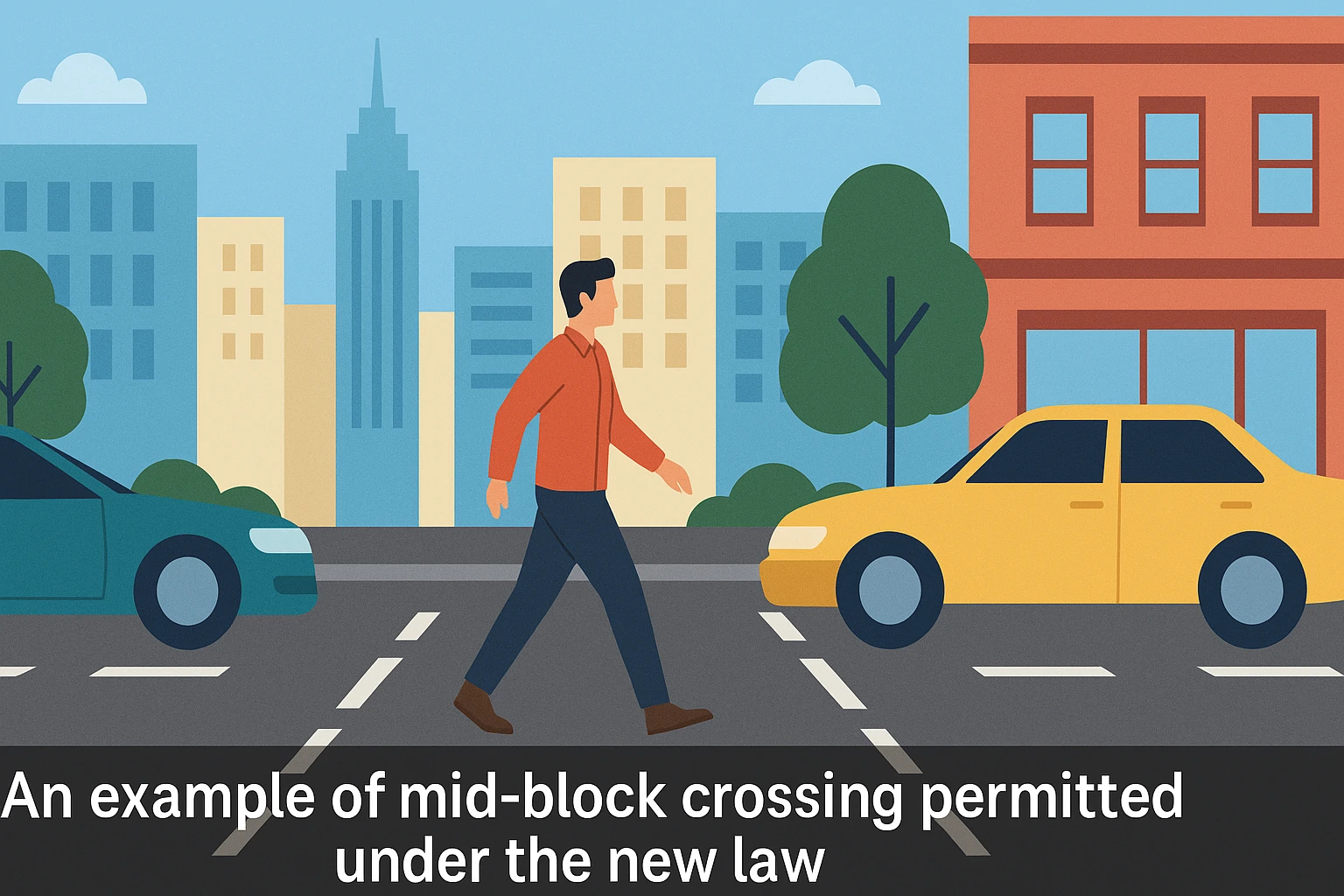
Let’s say you are walking in a quiet part of San Diego. No cars are coming. There’s no marked crosswalk, but you need to cross the street. Under the new law, you can do it without fear of a ticket, as long as your move is safe.
Now imagine you run across a busy Los Angeles road during rush hour. Cars honk. A driver hits the brakes. That is not safe. Police may stop you and issue a fine.
You must judge the moment. Look both ways. Make sure there’s no risk. If in doubt, use a crosswalk or wait for a walk signal.
Can Cities Still Make Their Own Rules?
Cities must follow state law, but some local rules may still apply. A city cannot override the state’s safety standard, but it can take steps to manage crossings in its own way.
For example, a city may put up signs, set crossing lights, or install barriers to guide traffic. These tools help organize movement and reduce crashes. But they cannot punish someone for safe crossing just because it’s outside a marked zone.
If a local police officer issues a ticket that does not follow state law, you may have a legal case. Always check with a lawyer if you feel your rights were violated.
Impact on Road Safety
Some people worry the new rule could make roads less safe. They fear more people will cross without thinking. They believe this could cause more crashes.
So far, there is no clear data to support that fear. In fact, some experts say the old laws did not stop unsafe crossings. People still crossed mid-block, whether legal or not. What matters more is how they do it.
By focusing on safety rather than location, the new law encourages smarter choices. People think more about timing, traffic flow, and visibility. This may lead to fewer careless moves.
Education also plays a role. When people learn the rules and why they exist, they act more wisely. The new law gives room for better habits, not just more tickets.
Jaywalking and Technology: Can Apps Help?
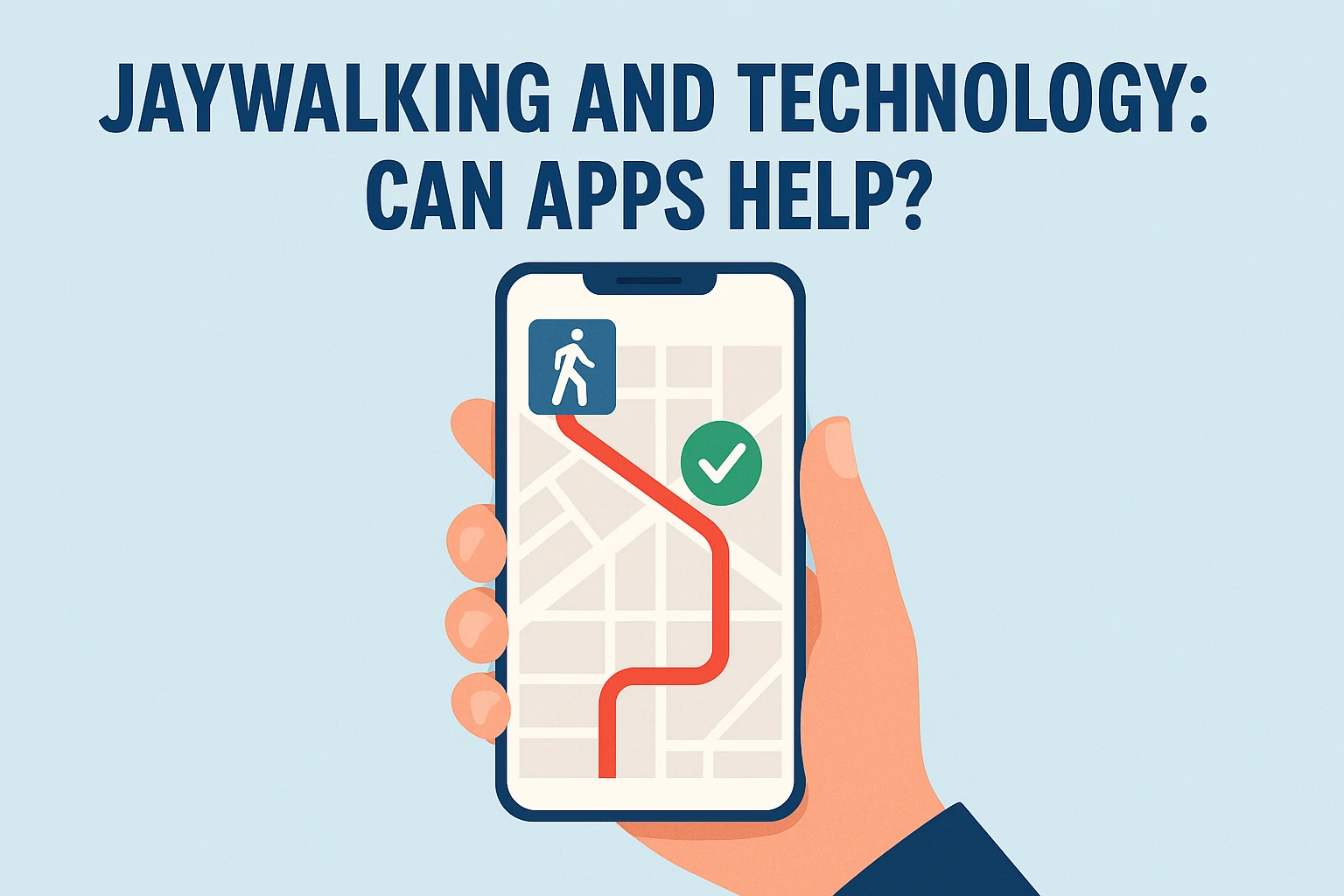
Modern tools now help people cross streets more safely. Many apps and devices give alerts, directions, or reminders that help walkers make better choices.
Some GPS apps show crosswalks and safe paths. They guide people to legal crossing points and warn about fast-moving roads. These tools help tourists or new visitors understand the area better.
Phones can also use motion sensors and audio cues. Some apps warn users when they approach busy streets while looking at a screen. These alerts reduce phone-related distractions and help people stop before stepping into danger.
Smartwatches and fitness trackers offer similar features. Some give gentle vibrations when you near a road. Others track how often you stop and check traffic, helping you form safer habits.
City tech also plays a role. A few places in California have started testing smart crosswalks. These crosswalks light up or change color when someone steps into them. They also warn nearby cars. This makes drivers and walkers more aware of each other.
These tools will not replace good judgment. But they offer real help. People who use tech wisely can lower their risk, avoid tickets, and walk more safely in busy areas.
What Happens If You Still Get a Ticket?
You can still get a jaywalking ticket in California if your crossing creates risk. If that happens, the cost could be over $100. You may also face court fees or processing costs.
If you feel the ticket was unfair, you have options. You can contest it in court. You may also contact a legal aid group. These groups often help people with traffic tickets or low incomes.
Always read the ticket fully. Look at the date, code section, and officer name. Save any photos or video that may support your side. Stay calm and follow the right process.
Tips to Stay Safe and Legal
- Look both ways before crossing.
- Cross only when no cars are near.
- Avoid distractions like phones or headphones.
- Do not run into traffic.
- Use marked crosswalks when available.
- Watch traffic signals and lights.
Use your freedom, but stay smart. The road is not just about cars. It belongs to everyone, and safety works both ways.
Related Resource: Learn how a Delray Beach Family Law Attorney can help you protect your rights and make smart legal choices.
Conclusion
Jaywalking in California is no longer what it used to be. The Freedom to Walk Act changed the game. People can now cross roads more freely, as long as they do it safely. The law aims to protect rights, reduce unfair policing, and make streets better for all.
Still, the rule does not give a blank check. It demands care and awareness. You must check traffic, judge risks, and avoid harm. If you cross without danger, you should be free to go. But if your action could lead to a crash, you may still face penalties.
This law marks a new chapter in California’s traffic rules. It gives more power to the pedestrian. It also sends a message: safety matters, but fairness matters too.
Whether you walk to work, take evening strolls, or just cross the street for coffee, this law affects you. Know the rules. Share them with others. Help build a safer and smarter way to walk in California.
This article is for general information only. It does not give legal advice. Always check local laws or speak to a lawyer if needed.

